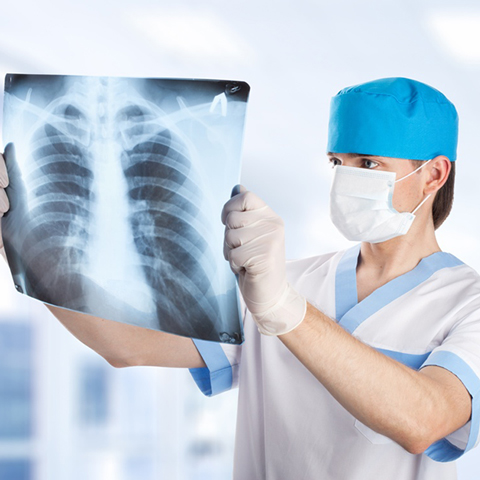
Thoracic surgery
St Luke’s operates a Department of Thoracic Surgery with specialized medical and nursing staff and is headed by the thoracic surgeon, Mr. Michalis Klimatsidas, a pioneer in the field in Greece and in the wider region.
Thoracic surgeons specialize in treating diseases or injuries to the structures of the chest cavity, such as:
- Heart
- Pericardium (membrane around the heart)
- Coronary arteries, valves and myocardium
- Trachea
- Esophagus
- Lungs
- Membranes around the lungs
- Chest wall
- Diaphragm
- What conditions does a thoracic surgeon treat?
- Thoracic surgeons treat a variety of conditions, including:
- Heart damage, including coronary heart disease and valvular disease
- Heart transplants
- Lung cancer
- Benign (non-cancerous) lung diseases and lung tumors
- Esophageal cancer
- Gastroesophageal reflux
- Emphysema
- Lung transplants
- Mesothelioma
- Tracheal resection
Thoracotomy
- Sphincterotomy. A sphincterotomy removes the tumor and tissue surrounding the cancer.
- Segmental resection. Segmental resection removes the tumor, blood vessels, lymphatic drainage, and the part of the lung where the tumor is located.
- Lobectomy. A lobectomy removes the entire lobe of the lung that has cancer, including the lymph nodes.
- Pneumonectomy. A pneumonectomy removes the entire lung with lymph nodes.
- Pleurectomy. A pleurectomy removes the inner lining of the chest cavity.
- Minimally invasive thoracic surgeries
Minimally invasive thoracic surgeries that may be performed to treat cancer include:
- Video-assisted thoracic surgery (VATS): During thoracoscopic surgery, the surgeon inserts a long, thin tube with an attached camera through a small incision in the chest. This instrument is called a thoracoscope. The operation is performed by the thoracic surgeon through the image provided by the thoracoscope on high-resolution monitors in the operating room.
- Robotic thoracic surgery: Like VATS, robotic thoracic surgery allows the surgeon to see the surgical field through a camera inserted into the chest. The surgeon operates at a console, using controls that translate the surgeon’s hand, wrist and finger movements into highly precise robotic movements.
A new era, that of robotic thoracic surgery, began at St Luke’s, where the first robotically assisted lobectomy with the Da Vinci X system was performed by the team of the thoracic surgeon specialized in minimally invasive and robotic thoracic surgery, Mr. Michalis Klimatsidas. This is the first operation in Greece, Cyprus, and the Balkans with this specific robotic surgery system, but also the first robotic thoracic surgery operation that has ever been performed in Northern Greece by a Greek thoracic surgeon.
Lung surgery
Lung surgery has made impressive strides in recent years with:
- Imaging techniques
- Pain management techniques
- Enhanced Recovery protocols, new tools, new techniques, such as thoracoscopic techniques
The use of the robot in Thoracic surgery
Now, operations are actually done through a keyhole, without expanding the sides of the chest, as was the usual technique in the past. For this reason, we now speak of surgery through a keyhole (keyhole surgery aka laparoscopy), which enables us to operate on patients even at the age of 87, if their physical condition allows it.
Endoscopic thoracic surgery
Endoscopic surgery of the chest is called Thoracoscopic surgery or VATS (Video Assisted Thoracic Surgery). In this technique, we use a camera and special long endoscopic tools, which open and close inside the chest so that they can fit into the chest cavity through a small hole. We use a monitor to perform the surgery with spectacular results in the patient’s recovery. It should be mentioned here that, lately, remote-controlled arms by the surgeon are also used, which are located on the so-called robot, with the surgeon all located in the same room and operated from a console, as a result of which we have much more “relaxed” surgeries for the surgeon and precision of movements.
Advantages of endoscopic thoracic surgery
- 15-20x magnification of the surgical field
- Much less pain
- Faster recovery
- Better recovery
- Quick return to everyday life
- Better aesthetic results (since the incision is about 3 cm and practically invisible)
- Much less cases of chronic pain.
The biggest advantage, however, is the fact that we can now safely operate on elderly patients, even 85+ years old, or others who are younger but heavily burdened with other health problems, to whom we previously could not give the opportunity to undergo thoracic surgery.


